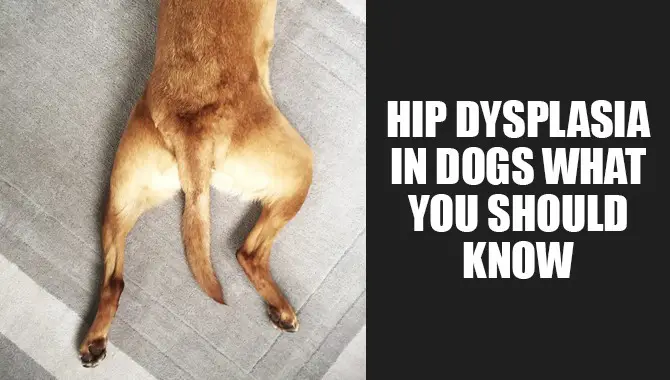Crate training is an important part of raising a happy, healthy, and well-behaved dog. Not only does it provide your furry friend with a safe and comfortable space to call their own.
But it also helps to prevent destructive behavi ours and aids in potty training. While confining your pet to a crate may seem daunting at first, with patience and consistency. And positive reinforcement, crate training can be a simple and stress-free process for you and your pup.
However, We will explore the benefits of crates, how to crate train a dog, and tips and tricks on how to get started from selecting the right crate to introducing your dog to the space. And gradually increasing the time spent inside, we’ve got you covered.
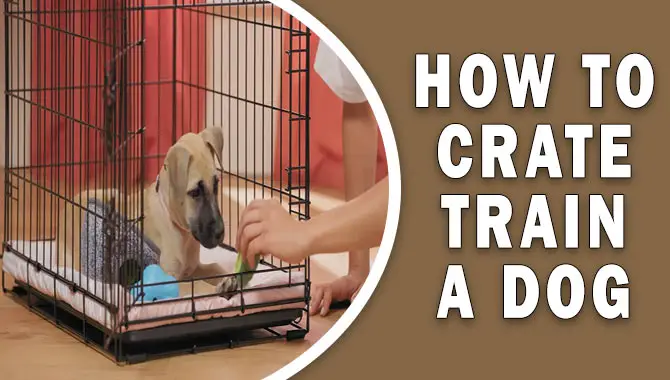
How To Crate Train A Dog Or Pappy: Explained
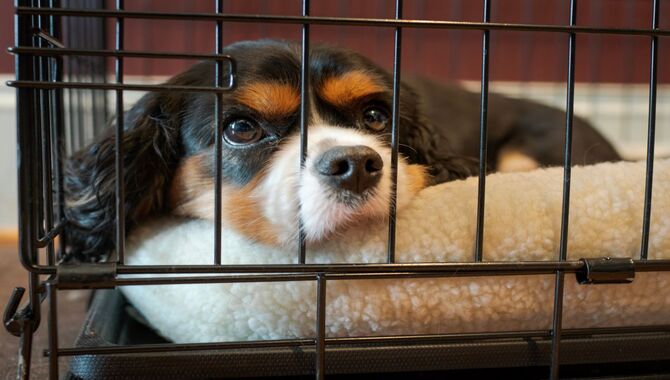
Crate training your pup can effectively provide them with their own safe space or den. First, introduce the crate gradually and positively using treats or their favourite toy to create a positive association. You should never leave your furry friend inside the crate for too long, as this can lead to whining, accidents, and separation anxiety. You should also ensure that the time spent inside is age-appropriate, whether dealing with a young pup or an older dog.
Gradually increase the time they spend inside while providing regular meals, toys, and positive reinforcement. Crate training is essential to raising a well-behaved and happy dog or puppy. It provides them with a safe and comfortable space to retreat to when they need some alone time or when they need to leave the house. How to crate train a dog or puppy, you should follow these simple steps:
Crating Caution
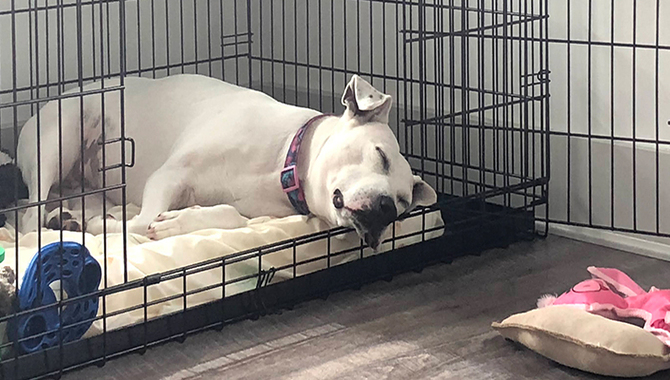
As you start crate training your dog or pup, be cautious about introducing them to the crate. It’s best to introduce the crate gradually and positively by using treats and a cheerful tone encouraging them to see it as a safe place. Begin with short periods in the crate while keeping a close eye on them to ensure their comfort and safety before extending it further.
Avoid leaving your furry friend inside the crate for extended periods of time, as it may cause whining or separation anxiety. Never use the crate as punishment if they have accidents or show excited behaviour; only use gentle redirection instead.
Supervise your pup when inside its crate; this ensures you catch any signs of fear or social isolation that may arise. Use positive reinforcement by providing a favourite toy or regular meals inside the crate during shorter periods before slowly increasing its duration. Remember to incorporate these small steps into their daily routine until they comfortably spend longer in their space.
Crate Selection
For successful crate training, choosing the right crate is essential. Ensure your dog has enough space to stand up, turn around, lie down comfortably, and stretch without restrictions. Consider adding their favourite toy or bedding to create a positive association with their new den.
When selecting a crate for potty training, ensure enough room. In the crate for a small blanket or towel on one end and a pee pad on the other. To prevent whining during longer periods in their safe space. Place them in their crate in the family room while you do household chores. Additionally, introducing short periods inside of the crate at first will help them adjust gradually before building up to longer periods.
The Training Process
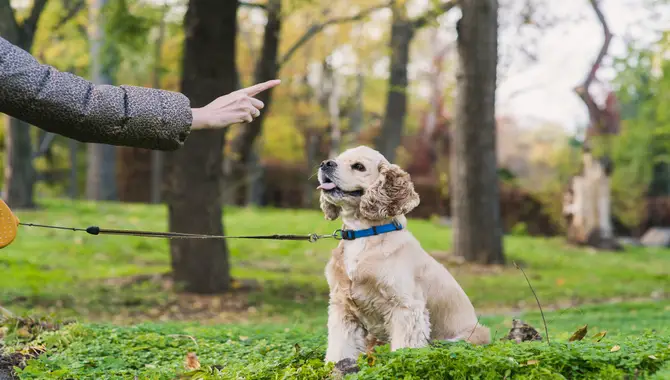
Crate training a puppy requires patience and persistence. Gradually introduce the crate to your pup, using positive reinforcement like treats and praise for good behavior. Avoid using the crate as punishment or leaving your pup inside for too long.
When starting the crate training process, keep creating shorter periods and slowly build up to longer ones over time. Ensure your puppy has plenty of regular meals in their crate with their favorite chew toy to keep them occupied. Positive association with the crate will make it a safe place for your pup when they need some alone time or a place to rest.
Introduce Your Dog To The Crate
When introducing your furry friend to their own space or den through crate training. Using positive association techniques like leaving their favorite toy or cosy bedding inside is essential. Encourage exploration and avoid overwhelming behaviors like whining. Start with shorter periods with the crate door closed while staying in the same room.
Gradually increase the length of time and repetition before allowing longer periods alone in the kennel. It’s important to remember that every dog’s temperament is different. Ensure you know how long they can remain without needing a potty break based on their age and bladder control. Create a safe place for them by providing regular meals and plenty. Of praise and treats as they gain comfort within their new space.
Feed Your Dog Meals In The Crate
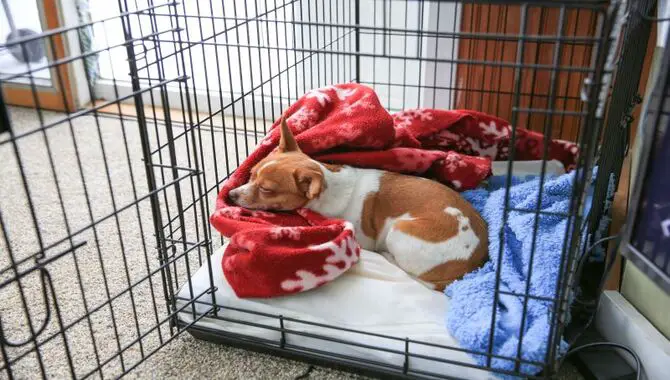
Feeding your dog its regular meals in its den can be an excellent method of creating a positive place for your pup. Start by placing their food dish near their kennel before gradually moving it inside. As they eat, keep the door to the crate open and slowly.
But surely reduce this time until they are happy spending longer periods of time inside. Remember never to use the crate as a sign of fear or punishment but as a safe space with many good things around, like bedding and chew toys.
Practice With Longer Crating Periods
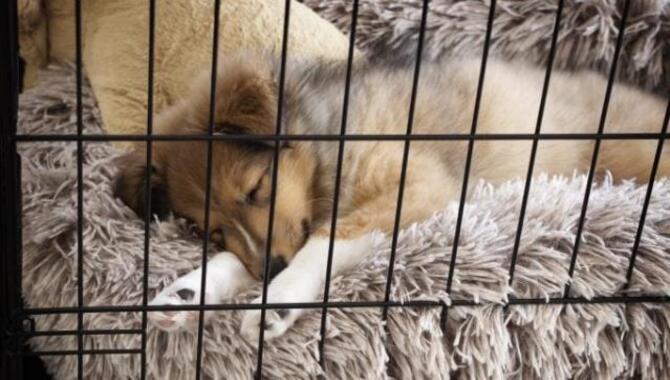
Crate training can be a useful tool for helping your dog feel safe and secure in their own space. Once your dog is comfortable with being in the crate for short periods, you can gradually increase the length of time they spend inside.
This will help them get used to spending longer periods of time in the crate without feeling anxious or stressed. Start by adding 5-10 minutes to their crating time and gradually increase it over several days or weeks. It’s important to ensure that you provide plenty of positive reinforcement. Such as treats or toys while your dog is inside the crate. With patience and consistency, your dog will learn to love their crate and see it as a haven where they can relax and unwind.
Crate Your Dog When You Leave
Leaving puppies alone at home can be challenging for pet parents. However, you can make this process stress-free by following simple steps such as ‘crate training.’ By creating puppies, while leaving them alone at home, you create a positive association between their den (the crate). And good things like their favourite toy, regular meals, and potty breaks. Introduce young puppies to a wire kennel divider placed in the family room or back of the crate for shorter time periods.
Start with small steps and gradually increase the crate time as they get used to being inside it. The moment your pup whines is an opportunity to teach them that whining. Is not how they get what they want; instead. Respond in a matter-of-fact tone with no eye contact or physical touch.
Crate Your Dog At Night
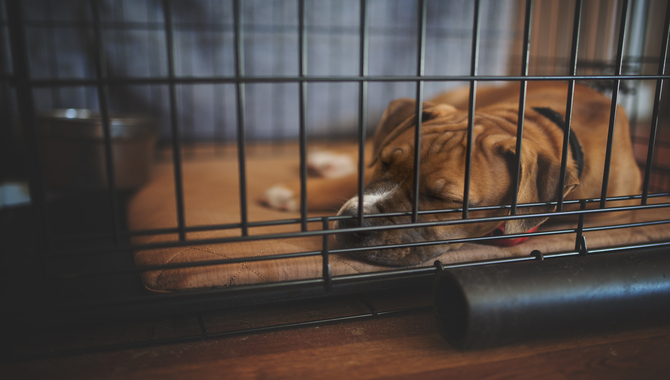
Crate training can be a great way to help your dog feel safe and secure in their own space. One important aspect of crate training is to crate your dog at night. This helps them establish a routine and teaches them to associate the crate with sleep and relaxation. When introducing your dog to its crate at night, make sure it is comfortable and cosy, with plenty of soft bedding.
You can also try leaving a piece of clothing with your scent in the crate, providing additional comfort for your dog. It’s important to remember that crate training should always be done gradually, with patience and positive reinforcement. Your dog will learn to love their crate as their little haven with time and consistency.
Potential Problems
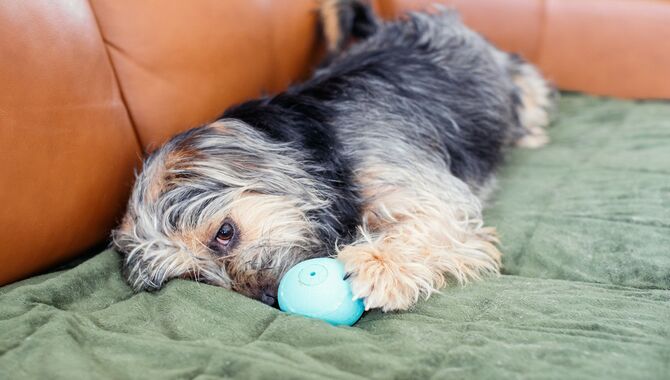
Successfully crate training a dog requires careful attention to potential problems that may arise during the process. Separation anxiety often results in destructive behaviour, and kennel aversion can occur if dogs have had negative experiences with crates.
Proper potty training takes place only when crate training is done correctly. Inappropriate sizing of crates can cause health concerns such as joint pain or stiffness. Maintaining consistency over time can be challenging but remember that repetition helps reinforce good habits for your pet. Fostering a positive association with a safe space of his own using bedding and favourite toys. And regular meals accompanied by enthusiastic praise will help puppies acclimate to their new den.
Other Reasons To Crate Train
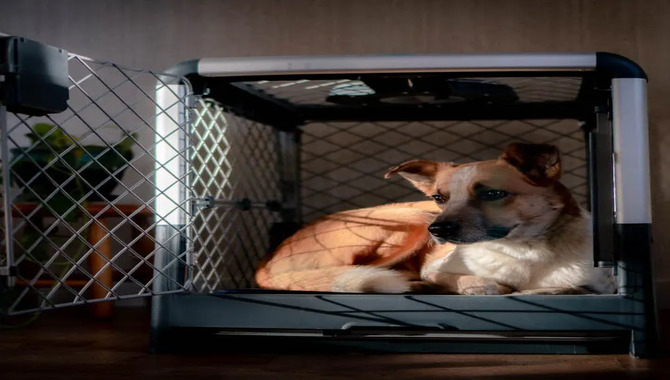
Crate training is a valuable tool for puppies and older dogs alike. It offers a safe place for your pup to call its own space and establishes a regular routine to help with potty training. Crate training can also help prevent excited or destructive behaviour in the family room by providing your pet with its favourite chew toy. One thing to remember is that you should never use the crate as punishment or leave your dog in there for extended periods of time; instead.
Focus on creating a positive association between your dog and their crate by using positive reinforcement techniques like giving them treats or enthusiastic praise when they enter their kennel voluntarily. To ensure crate training is effective and comfortable for your pet, choose an appropriately sized wire or plastic crate that gives them enough room to stand up comfortably but not so much space that they start whining during shorter periods.
Do’s & Don’ts
Pet owners must follow specific dos and don’ts to ensure successful crate training for puppies or adult dogs. Begin by providing a comfortable den-like space for your dog using positive reinforcement like favourite toys, regular meals, and bedding. Avoid using the word “crate” when introducing your pup to his new space. Instead, use phrases like “puppy apartment” or “safe place.”
Do not force your pup into the crate; let him investigate his new living quarters at his own pace. Gradually introduce longer periods in the crate- including overnight- while in close proximity like in the family room so that he knows you’re nearby.
How Long Does Crate Training Take?
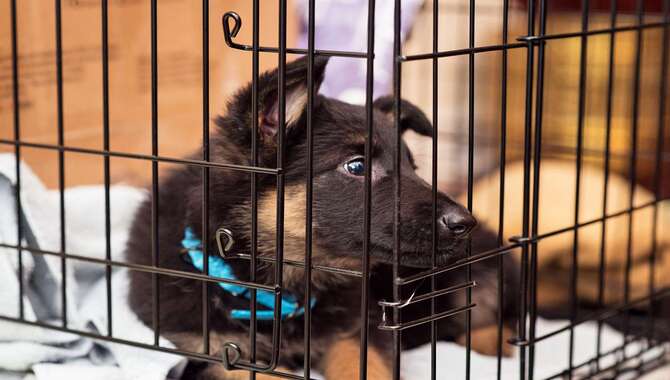
Crate training a dog can take anywhere from a few days to several weeks, depending on the individual dog’s temperament and past experiences with crates. It is important to approach crate training with patience and consistency, as forcing or punishing a dog during the process can lead to negative associations with the crate.
To begin crate training, start by introducing your dog to the crate in a positive way, such as placing treats or toys inside and allowing them to explore it at their own pace.
Gradually increase the time they spend in the crate, providing plenty of positive reinforcement and rewards for good behaviour. With time and patience, most dogs can learn to see their crate as a safe and comfortable space in which they enjoy spending time.
What To Know Before Starting Crate Training
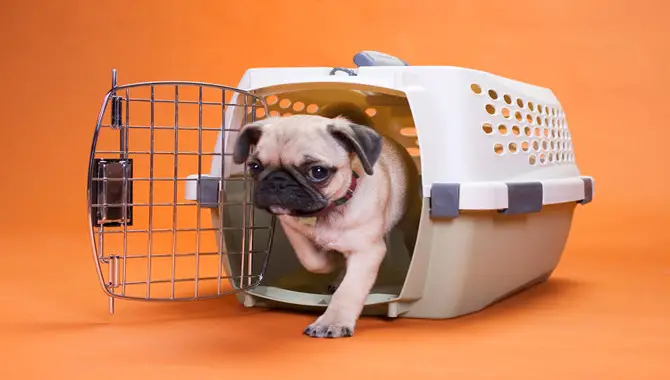
Crate training is a great way to provide puppies and dogs with a safe space or den. Before starting crate training, it is important to understand its purpose and how it can benefit your furry friend positively. Begin by choosing an appropriate size and location for the crate, based on their comfort and safety.
Ensure that you introduce the crate gradually with positive associations, such as treats or a favourite chew toy, while keeping a happy tone of voice. It is essential to start with shorter periods in the beginning before progressing to longer periods as your pup gets used to spending time inside its own space.
Conclusion
Crate training can be a valuable tool for you and your furry friend. It provides a safe and secure space for your dog to call their own, which can reduce anxiety and stress. However, it is essential to approach crate training with caution and patience, as it can take time for your dog to adjust. Remember to select the right crate size, introduce your dog gradually, and use positive reinforcement throughout the process.
Your dog will learn to love their crate as a comfortable and familiar space with consistency and practice. However, it is important to remember that crate training should never be used as punishment or as a substitute for proper exercise and socialization. With patience, consistency, and positive reinforcement, you can successfully crate-train your furry friend and set them up for a happy and healthy life. We hope now you understand how to crate train a dog
Frequently Asked Questions
What Are The Benefits Of Crating A Dog?
Using a crate can offer a secure environment for your dog while you’re away, help with house training, prevent destructive habits and mitigate anxiety or fear. However, it’s important to introduce the crate positively and ensure it’s not overused or used as punishment.
Can I Crate My Puppy Until They’re 2 Years Old?
It is not advisable to crate your puppy for two years. Puppies need socialization and exercise which cannot be achieved by being in a crate all day. A crate should never be used as punishment. Gradually increasing crate time while providing toys and treats can ease them into crate training.
Should I Use Any Kind Of Crate, Or Do You Recommend One Specific Type?
The ideal crate for your dog depends on its size and behaviour. You can choose from wire, plastic, or soft-sided crates based on your preference. Select the right size for your dog and consult a vet or trainer if needed.
How Can I Ensure My Puppy Is Comfortable In Their Crate While We’re Not Home?
To ensure your puppy is comfortable in their crate while you’re away, gradually introduce them to it with treats and toys, choose the right size crate, make it cosy by covering it with a blanket, and start leaving them in it for short periods of time before gradually increasing the duration as they get used to it.
Do Puppies Need Exercise And Mental Stimulation While In Their Crates?
Puppies require exercise and mental stimulation even while in their crates. Interactive toys like puzzle feeders and short play sessions outside the crate can help. Gradual increases in crate time with positive reinforcement aid successful crate training.

Aquarium passion is all about connecting with the aquatic life and providing education to the public on the importance of these creatures. We showcase a wide variety of marine life through our exhibits as well as working with schools to provide unique learning opportunities for students of all ages.




